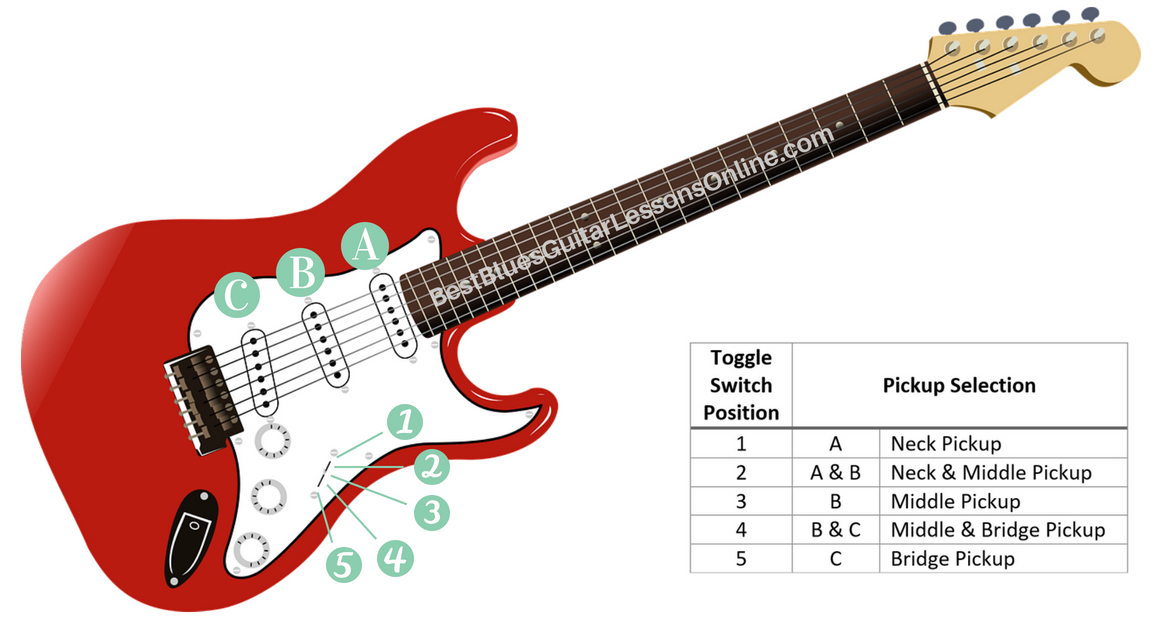Guitar Knobs Explained: The Best And Worst Settings To Play Blues Guitar
How To Master Your Guitar Sound With The Guitar Toggle Switch And The Guitar Tone Knobs
By Antony Reynaert
It doesn’t matter if you have been playing the guitar for over 20 years now or you’ve just started out yesterday, the truth is that wrong settings of the guitar knobs can demolish all your great effort.
The knobs on the guitar and the toggle switch may look small, but what they do is of major importance. Even with the perfect amp settings, the wrong position of the toggle switch and/or tone knobs can totally ruin your overall sound.
In this article you’ll discover all the mysteries concerning the guitar knobs on an electric guitar so you know exactly what settings to use in order to play with your favorite blues sound.
How To Control Your Guitar Sound With Guitar Knobs
The first component we will talk about is the pickup selector, also known as the toggle switch. In this case, on my Fender Stratocaster, we are dealing with a 5-way pickup selector. Other guitars, like a Gibson Les Paul, might have a 3-way switch. The switch decides which pickup will transfer the vibrations of the strings into an electric signal. Knowing which position of the toggle switch uses which pickup(s) is extremely important as every pickup sounds completely different. Let’s take a look at the image below:

The very important first step is to memorize the different combinations in which the toggle switch can select the pickups. As the selections result in different sounds, knowing the sound each pickup creates is therefore the crucial next step to take in this journey.
Position 1 on the pickup selector is connected to the neck pickup, the warmest sounding pickup on the guitar. If you jump to position 5, you empower the bridge pickup. In contrast to the warm sounding neck pickup, the bridge pickup has a very sharp sound.
Less warm in sound, but still not that sharp is the middle pickup. You can consider this one more neutral and soft sounding.
Besides the three toggle switch positions that empower a single pickup, there are still two more positions to discover. Each of them is formed by a combination of two pickups. A warm sound, but a little less defined than the neck pickup is what you get from position 2. Position 4 is sharp sounding, but with a softer edge.
You can conclude that every time we move the toggle switch closer to position 1, the sound gets warmer. If you move the switch closer to position 5, the sound becomes sharp. In the video you can clearly hear the difference in sound between all the positions and the pickups connected to it.
How To Define The Best Pickup Selections For Blues Rhythm Guitar Playing
Using the right pickup on the right moment seems a hard task. You have to mind your playing and you must consider which sound and which pickup suits best with what you are playing! Even during your blues solos or blues riffs, you should be switching between the different pickups. You have to think about what the music needs. In a rock situation, position 5 might come in handy. Funk chops sound very cool in position 4 (especially on a Stratocaster). For blues soloing you can consider position 1 for a big and warm sound. On the other hand, Stevie Ray Vaughan also used position 3 for his insane and signature blues sound. There are a lot of different genres, each one will sound better with a specific pickup. In the video above I demonstrate how you can make rock riffs and blues riffs sound with different selections.
The Best And Worst Toggle Switch Positions For Blues Soloing
Not only as guitarists, but also as musicians, we try to discover new tricks that keep what we do interesting. Always playing the same drum groove, always using the same chord progression on the piano, … After a while, it gets old. Lots of guitarists do exactly the same boring things over and over such as playing the same lick or scale over and over again. Playing higher and lower on the neck is one solution for better results in your lead playing as using a larger area on the neck of the guitar enables different pitch ranges to expand your melodies or riffs.
When you watch performances of great blues guitarists, you will see how they play the most amazing blues solos and how they switch pickups while they are doing that! While they are playing certain licks, they know which sound they want when they play them. You are free to experiment with this, but keep in mind that some combinations are not always that good. For example: when playing high on the neck of the guitar, the bridge pickup will make the high notes way too sharp. The neck pickup is much smoother and will make these notes sing. Playing in the lower range of the fretboard is the perfect situation for the sharp and 'ripping' bridge pickup tones your riff is asking for. Keep these tips in mind, but remember to experiment freely!

Watch the video above and listen to some examples I play. In these examples you will hear why it is better to avoid using the bridge pickup when you are playing higher on the neck of the guitar.
Incorporate The Tone Knobs To Fine-Tune And Completely Master Your Guitar Sound
When you fully understand how the toggle switch functions, the next step is to learn how to use the tone knobs on your guitar. When you know how to use these, you will be able to get the best sound out of your guitar.
When you turn the tone knob all the way down, all the high frequencies are cancelled. Only the low ones stay. This way, you lose all the definition of that specific pickup. This less defined tone can be useful for some jazzy sounds or in combination with a good distortion, you can have some everlasting tones. Instead of turning down the tone knob completely, you can turn it down a little bit to smooth out the high frequencies of your sound. This can be very useful when you are using the bridge pickup and you don’t want to make people’s ears blead. Again, experiment and discover what your favorite settings are for your own unique blues sound!
Learning to use the guitar knobs goes hand in hand with learning to play blues guitar properly. If you want to take your guitar solos to the next level, you can download my free guide, How To Play More Advanced Guitar Solos, filled with the best tips on how to accelerate your guitar playing progress to a more advanced level.
Ready to take the next step in your blues guitar playing? Learn about the Essential Blues Guitar Soloing Lesson.

